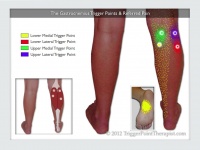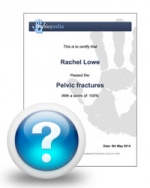Gastrocnemius
Original Editor Aarti Sareen
Top Contributors - George Prudden, Aarti Sareen, Rishika Babburu, Admin, Andeela Hafeez, Kim Jackson, WikiSysop, Joao Costa, Lucinda hampton, Evan Thomas, Venus Pagare, Samuel Adedigba and Daphne Jackson
Description[edit | edit source]
Gastrocnemius forms the major bulk at the back of lower leg and is a very powerful muscle. It is a two joint or biarticular muscle and has two heads and runs from back of knee to the heel. The definitive shape of the calf is as a result of the medial and lateral heads of the gastrocnemius, which are situated at the posterior, upper half of the lower leg. With the soleus and plantaris, they form a composite muscle called the triceps surae. The two heads of the muscle form the lower boundaries of the popliteal fossa.[1]
Anatomy[edit | edit source]
Origin[edit | edit source]
The two heads are located from the medial and lateral condyles of the femur.
The medial head from behind the medial supercondylar ridge and the adductor tubercle on the popliteal surface of the femur. The lateral head from the outer aspect of the lateral condyle of the femur, just superior and posterior the lateral epicondyle.
Both heads have attachments from the knee joint capsule and from the oblique popliteal ligament.[1]
Insertion[edit | edit source]
The bulk of the gastrocnemius muscle from each of the heads come together and insert into the posterior surface of a broad membranous tendon. It then fuses with the soleus tendon to form the upper part of tendocalcaneus. This broad tendon then narrows until it reaches the the calcaneous where it expands again for its insertion on the middle part of the posterior surface of the calcaneus.[1]
Nerve supply[edit | edit source]
Both heads of the gastrocnemius is supplied by the tibial nerve (S1 and 2). Cutaneous supply is mainly provided by L4, 5 and S2.[1]
Function[edit | edit source]
The gastrocnemius with the soleus, is the main plantarflexor of the ankle joint. The muscle is also a powerful knee flexor. It is not able to exert full power at both joints simultaneously, for example when the knee is flexed, gastrocnemius is unable to generate as much force at the ankle. The opposite is true when the ankle is flexed.
When running, walking or jumping the gastrocnemius provides a significant amount of propulsive force. Consider the amount of force required to propel the body into the air, triceps surae can generate a lot of force. [1]
Assessment[edit | edit source]
Palpation[edit | edit source]
At the posterior aspect of the knee joint, the two large muscle bellies of gastrocnemius can be felt on either side of the upper portion of the calf. The medial head is projects higher and is lower than the lateral. Both can be felt joining the tendinous junction.
Further down the calf is the flattened tendocalcaneus which can be palpated to its insertional attachment at the posterior surface of the calcaneus.[1]
Power[edit | edit source]
- Ankle plantarflexion in long-sitting (consider that gastrocnemius works against full body on a daily basis).
- Double/single leg calf raise
- Straight leg jump
- Functional tasks (steps, etc.)
Length[edit | edit source]
- Passive dorsiflexion
- Body-weight lunge, measure the straight back leg.
Treatment[edit | edit source]
Weakness[edit | edit source]
- Nonweightbearing and basic weightbearing exercises such as theraband exercises, double and single leg calf raises.
- Weight-bearing exercises and gradually progresses stability exercises by (i) increasing load (ii) increasing the repetitions (iii) varying surface, for example introducing a wobble board
- Sport-specific movement patterns such as running, jumping, and bounding.
Trigger Points[edit | edit source]
The gastrocnemius may contain up to four trigger points.
- The two medial trigger points lie in the medial head of the gastrocnemius, with the upper trigger point found just below the crease of the knee, and the lower trigger point an inch or two below it.
- The two lateral trigger points in the lateral head mirror the positioning of the medial trigger points, except that they lie slightly more distal (towards the foot) by about a half-inch.[2]
Resourses[edit | edit source]
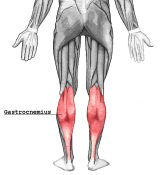
|

|

|
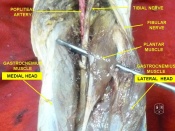
|
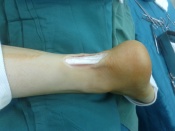
|
See also[edit | edit source]
- Achilles rupture
- Achilles tendinopathy
- Achilles tendon
- Baker's cyst
- Calcaneal fracture
- Calf strain
- Deep vein thrombosis
- Fabella syndrome
- Thompson test
- Soleus
Read 4 Credit[edit | edit source]
|
Would you like to earn certification to prove your knowledge on this topic? All you need to do is pass the quiz relating to this page in the Physiopedia member area. |
References[edit | edit source]

